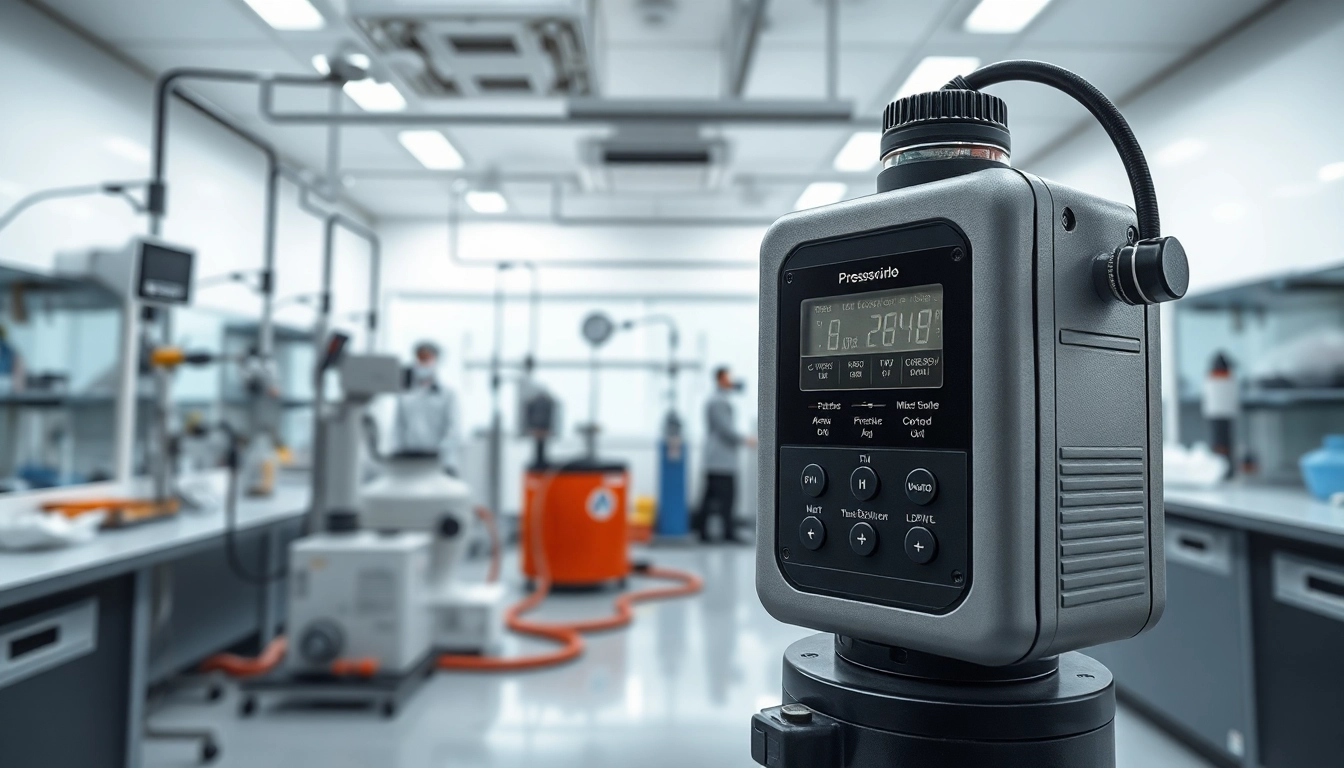Ensure Safety with Advanced Hydrogen Peroxide Gas Detector Solutions
Understanding Hydrogen Peroxide Gas Detection
Hydrogen peroxide (H2O2) is a powerful oxidizing agent commonly used for its disinfectant and bleaching properties. It’s utilized in various industries ranging from healthcare to food processing. However, the presence of hydrogen peroxide gas in the environment, especially at high concentrations, can pose serious health risks. Detecting this gas accurately is crucial for maintaining safety standards in workplaces and other settings where hydrogen peroxide is used. An effective Hydrogen Peroxide gas detector is essential for monitoring air quality and ensuring the safety of personnel.
What is Hydrogen Peroxide and Its Uses?
Hydrogen peroxide is a colorless liquid that appears similar to water but has distinct chemical properties. It’s primarily recognized for its efficacy as a disinfectant and antiseptic. In smaller concentrations, it is often used for household cleaning and personal care products, while industrial-grade hydrogen peroxide is employed for applications such as waste treatment, paper bleaching, and textile processing.
In the medical field, hydrogen peroxide serves as a disinfectant for surgical instruments and skin abrasions due to its antimicrobial properties. Despite its widespread utility, it is essential to handle hydrogen peroxide with care, particularly in gas form, as exposure can lead to respiratory issues, skin irritation, and at extreme levels, it can be corrosive.
The Importance of Safe Detection
Safe detection of hydrogen peroxide gas is vital for ensuring workplace safety, protecting employees, and complying with regulations set by health and safety authorities. Hydrogen peroxide can produce toxic fumes that compromise air quality and pose health risks, making it essential to utilize reliable detection systems.
Undetected leaks can lead to dangerous situations, including chemical burns, respiratory problems, and even explosions in certain conditions. Therefore, implementing an effective gas detection system is not merely a regulatory requirement but a crucial aspect of employee health and safety management.
How Hydrogen Peroxide Gas Detectors Work
Hydrogen peroxide gas detectors operate using various technologies to identify the presence of hydrogen peroxide in the air. Most commonly, these detectors utilize chemical sensors that react when hydrogen peroxide gas is present, generating an electrical signal proportional to the gas concentration.
Some advanced detectors utilize infrared spectroscopy, which measures the absorption of infrared light by molecules in the environment. This method allows for accurate measurements of hydrogen peroxide concentrations, even at low levels. Electrochemical detectors are another prevalent type, relying on chemical reactions to produce an electrical output in response to hydrogen peroxide exposure.
Types of Hydrogen Peroxide Gas Detectors
Chemical-Sensitive Detectors
Chemical-sensitive detectors are among the simplest forms of hydrogen peroxide detection. They typically use a sensor that contains materials that undergo a chemical change in the presence of hydrogen peroxide. This change results in a measurable output, alerting users to the gas’s presence.
These detectors are ideal for smaller environments where budget constraints might be an issue. However, they may require frequent calibration and maintenance to ensure accurate readings, particularly in environments where gas concentrations fluctuate widely.
Infrared and Electrochemical Detectors
Infrared detectors are highly sensitive and capable of detecting very low concentrations of hydrogen peroxide gas. They measure the absorption of infrared light, making them suitable for continuous monitoring in environments with varying temperatures and pressures.
On the other hand, electrochemical detectors are widely used due to their reliability and ease of use. They respond to hydrogen peroxide by undergoing a chemical reaction that produces a measurable current, indicating the gas concentration. These detectors are typically used in portable devices for personal safety and permanent installations in various workplaces.
Choosing the Right Detector for Your Needs
When selecting a hydrogen peroxide gas detector, it is essential to consider several factors, such as the expected concentration levels, environmental conditions, and the specific application. Facilities with high hydrogen peroxide usage may require advanced infrared or electrochemical detectors for round-the-clock monitoring.
Additionally, the choice may also be influenced by budget constraints and the available technical support. Consulting with a safety professional can help ensure the selection of the most appropriate detection technology for an organization’s specific needs.
Key Features of Effective Hydrogen Peroxide Gas Detectors
Response Time and Sensitivity
The response time and sensitivity of a hydrogen peroxide gas detector are critical characteristics that determine its effectiveness. A detector must be able to respond quickly to changes in gas concentrations to mitigate health risks immediately.
High-quality detectors can provide near-instant readings, allowing for appropriate responses to leakage or spikes in hydrogen peroxide levels. Sensitivity thresholds can vary; thus, it is important to select a detector that can accurately register low levels of gas if the application requires it.
Calibration and Maintenance Requirements
Regular calibration and maintenance are paramount to ensure the accuracy and reliability of gas detection systems. Different models have varying maintenance requirements; however, general guidelines suggest frequent checks and periodic calibration to comply with safety regulations.
In most cases, it’s advisable to develop a routine maintenance schedule, which can include checks, sensor replacement, and system audits to guarantee that the detectors perform optimally over time.
Integration with Safety Systems
Integrating hydrogen peroxide gas detectors with existing safety systems can substantially enhance overall workplace safety. These detectors can be linked to alarm systems to provide immediate alerts in case of gas leaks, thereby facilitating prompt action to safeguard personnel.
Moreover, integration with health and safety monitoring platforms allows for real-time data analysis, enabling informed decision-making and safety reporting. This holistic approach ensures that all safety measures work together seamlessly for enhanced protection against hazardous gas exposure.
Challenges in Hydrogen Peroxide Detection
Common Issues and Solutions
Several challenges can arise in the accurate detection of hydrogen peroxide gas. One issue is sensor poisoning, where the sensor becomes less sensitive due to exposure to incompatible chemicals. Regular maintenance, including cleaning and appropriate calibration, can mitigate this problem.
Environmental factors, such as temperature fluctuations and humidity, can also impact detector performance. Choosing the correct type of sensor for the prevailing conditions and ensuring proper installation can alleviate these challenges and enhance detection reliability.
Environmental Factors Impacting Detection
Hydrogen peroxide gas detectors can be influenced by environmental conditions such as temperature, humidity, and the presence of other gases. Elevated temperatures may affect sensor accuracy, while high humidity levels can lead to false positives or negatives.
Proper sensor placement and shielded installations can help reduce the impact of these environmental variables on detection capabilities. Additionally, selecting detectors designed to operate efficiently within a specified range of temperature and humidity can further enhance reliability.
Regulatory Compliance and Standards
Adhering to regulatory standards is crucial for any facility that handles potentially hazardous materials like hydrogen peroxide. Various organizations, including OSHA (Occupational Safety and Health Administration) and NIOSH (National Institute for Occupational Safety and Health), set guidelines that dictate safe exposure limits and detection requirements.
To meet these compliance laws, it is essential to stay informed about industry standards and incorporate the necessary measures into safety protocols. Failing to comply can lead to legal ramifications and compromise employee safety.
Implementing Hydrogen Peroxide Gas Detection in Your Facility
Evaluating Risks and Requirements
Before implementing a hydrogen peroxide gas detection system, it’s vital to conduct a thorough risk assessment of the facility. Identifying areas where hydrogen peroxide is used will help delineate any high-risk zones that require monitoring.
Additionally, evaluating the concentrations of hydrogen peroxide that employees may encounter and understanding local regulations can aid in determining the type and number of detectors needed for comprehensive coverage.
Step-by-Step Guide to Installation
Installing a hydrogen peroxide gas detection system involves several key steps:
- Site Assessment: Examine the facility to identify locations with potential hydrogen peroxide exposure.
- Detector Selection: Based on risk assessment, choose the appropriate type and number of detectors.
- Installation Plan: Create a plan for sensor placement that maximizes coverage while adhering to safety guidelines.
- Installation: Follow the manufacturer’s instructions carefully during the installation process to ensure proper functionality.
- System Testing: Conduct thorough testing of the installed system to confirm that detectors are operating correctly.
- Documentation: Keep records of the installation process and testing outcomes for compliance and maintenance purposes.
Training Staff on Safety Protocols
Training staff on safety protocols related to hydrogen peroxide and gas detection systems is critical for ensuring workplace safety. Employees should be educated about the properties and hazards associated with hydrogen peroxide gas, as well as the importance of gas detection systems in minimizing risks.
Regular training sessions should be organized to familiarize personnel with detector functionality, emergency response protocols, and first-aid procedures in the event of exposure. This empowerment not only promotes a safety-first culture but also encourages proactive risk management in day-to-day operations.










